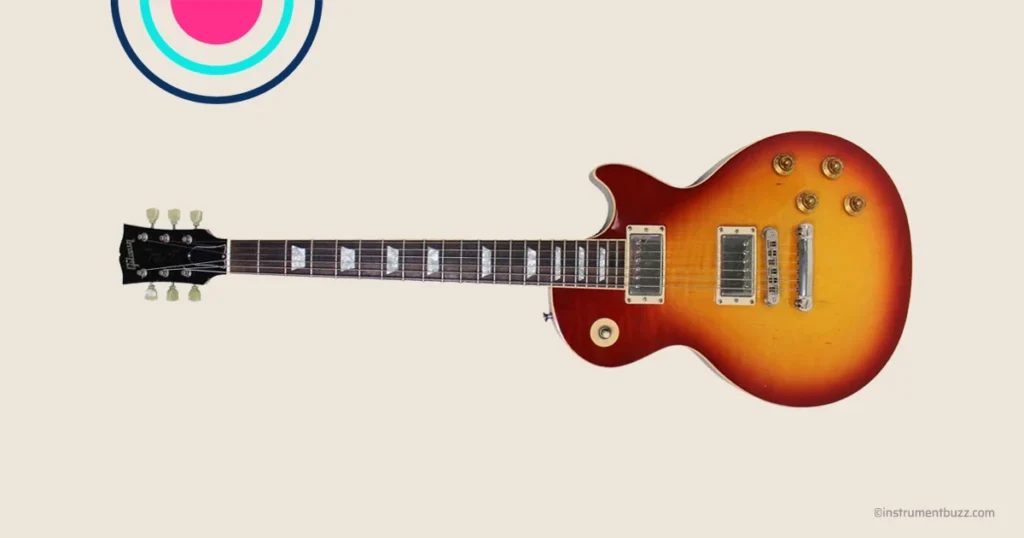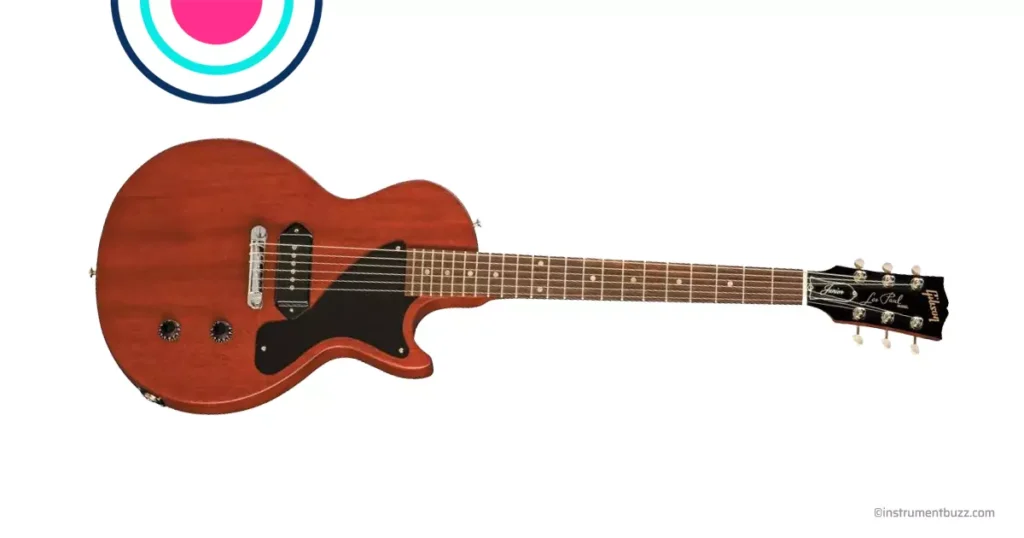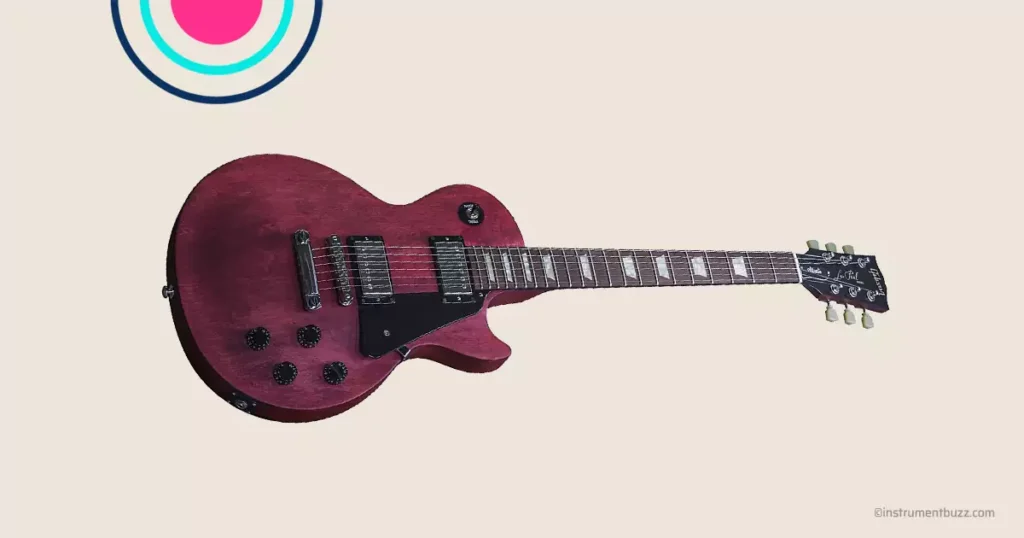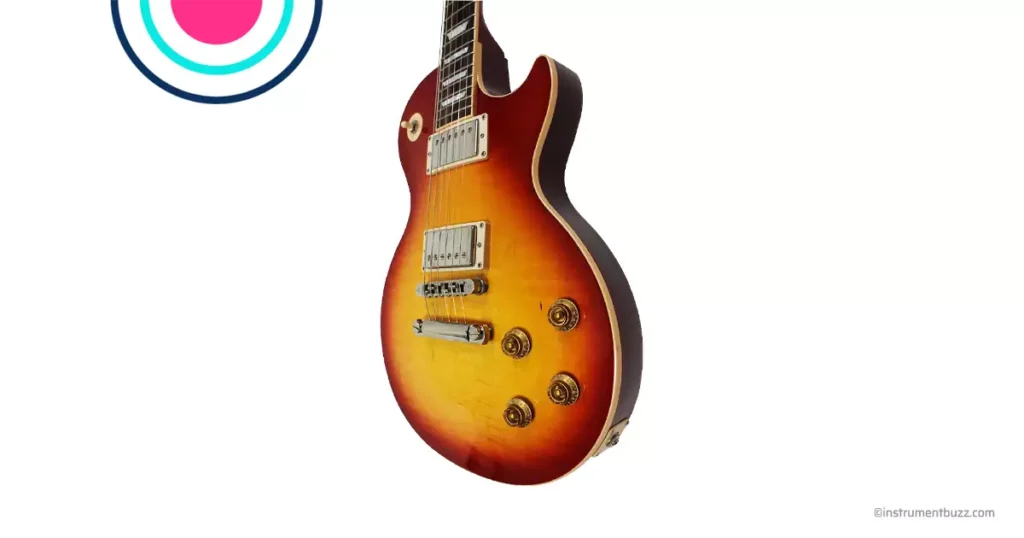At first appearance, it may be challenging to tell an Epiphone Les Paul from a Gibson Les Paul, but there is a significant price difference between the two guitars. The Epiphone vs. Gibson argument may be the most popular on guitar forums. Guitarists frequently ask: What distinguishes an Epiphone from a Gibson? How does Epiphone compare to Gibson? Should I put off buying a Gibson in favor of an Epiphone?
This review could put your mind at ease if this bothers you. But first, a brief introduction before we get to the point: The question of whether to choose an Epiphone or a Gibson cannot be definitively answered.

On one extreme, some only use Gibsons and wouldn’t dare touch an Epiphone. They view the Epiphone population as simple-minded and uninformed.
In fact, Gibson and Epiphone guitars are both excellent instruments, and each has its advantages. In this post, we will be discussing these two guitars and a comparison between them.
Epiphone Les Paul
Many people believe that Gibson’s Les Paul guitar is an exact replica of Gibson’s products. However, the Epiphone Les Paul is a genuine Les Paul since Gibson owns Epiphone. This does not imply that the Gibson Les Paul and the Epiphone Les Paul are interchangeable. Epiphone Les Paul guitars are made abroad.
The pricing difference between the Epiphone LP and the Gibson LP is mostly due to this. Epiphone guitars use lower-quality components and labor since they are not manufactured in the United States.
Epiphone Les Paul is an excellent electric guitar manufactured by Epiphone. This guitar comes with a nice finish, a high-quality neck, good pickups, and a comfortable body that allows you to practice and play all day long.
The Epiphone Les Paul is the best electric guitar for beginners because of the many advantages that this guitar has. You can choose from a wide range of Epiphone Les Paul models, including the Standard, Deluxe, and Special models, which will satisfy even the most demanding guitar enthusiast.

The Epiphone Les Paul guitar has a very good reputation and is highly recommended to all types of guitar players. The guitar comes with a Tune-O-Matic bridge. The bridge allows the guitarist to set the bridge height and tuning pins to the desired string length. The tuning pins are fixed in the neck, so the guitar neck cannot be altered.
There are several other Epiphone Les Paul models on the market today, and these include the Les Paul Special Edition, Les Paul Standard, Les Paul Custom, Les Paul Special Goldtop, Les Paul Custom Goldtop, and Les Paul Studio. Each of these guitars has its own unique characteristics, which allow them to produce different sounds.
Gibson Les Paul
Gibson bought the Epiphone name in 1957, but they continued to make their own exclusive guitars for many years after. However, in order to produce an accessible range of models that were comparable to their premium US guitars, Gibson granted the Epiphone brand a production license for Gibson models in the early 1980s.
Since that time, the only legally authorized clones of Gibson’s most well-known models, the Les Paul and the SG, have been sold under the Epiphone brand.
The Gibson Les Paul is a legendary guitar from the 1960s. Its signature humbucking pickup configuration and modern designs have become a standard for electric guitars. And the Gibson Les Paul has remained popular as a favorite guitar for blues players and rock musicians since its introduction.
The guitar is a versatile instrument that provides a wide range of tones, from its traditional jangly lead tones to the hard, distorted tones that define the classic rock era. The Gibson Les Paul was originally produced in the 1950s, and it became popular in the 1960s with rock musicians.

The Gibson Les Paul is a double-cutaway acoustic-electric guitar. It has a set of mahogany neck and mahogany body and a rosewood fingerboard. It has a single coil pickup, which gives it a distinctive and crisp tone. The Gibson Les Paul has a 24.75-inch scale length and comes in a black finish.
The Gibson Les Paul features a solid top, three single-coil pickups, and a master volume. Gibson Les Paul reemerged with several new models such as the Les Paul Custom, Les Paul Studio, Les Paul Traditional, and Les Paul Special.
The Les Paul has since become a staple in any guitarist’s collection, and this guitar continues to be a favorite amongst players looking for that classic sound.
Difference Between Epiphone Les Paul And Gibson Les Paul
The primary differences between the Epiphone Les Paul and Gibson Les Paul guitars lie in their construction materials, craftsmanship, price, and overall sound quality. Epiphone, as a subsidiary of Gibson, offers more affordable versions of the Les Paul, making them popular among beginners and budget-conscious players.
These guitars are typically made with less expensive materials and manufactured overseas, which contributes to their lower price. The Gibson Les Paul, on the other hand, is renowned for its superior craftsmanship, higher-quality woods, and components, and is made in the United States.
This results in a richer, more nuanced sound, preferred by many professional musicians. However, the cost of a Gibson Les Paul is significantly higher, reflecting its premium build quality.
In summary, while both guitars share a similar design and heritage, the Gibson Les Paul stands out for its exceptional build and sound quality, whereas the Epiphone Les Paul offers a more affordable alternative with respectable performance.
Some Background
The histories of both Gibson and Epiphone are exceedingly lengthy and tumultuous. We just don’t have time to go into the multiple ownership changes, several bankruptcies, and protracted legal battles that have taken place here; when a business is over 100 years old, a lot may happen. So let’s just concentrate on the achievements.
Gibson began his career in Kalamazoo, Michigan, way back in 1902. However, they didn’t start out with guitars; instead, they used the mandolin, a quite different sort of classical guitar.
A leader in flat-top acoustic guitars, a pioneer of jazz archtops, and one of the first commercially accessible electric hollow-body guitars, Gibson had made a name for themselves in the six-string world by the 1930s.
Nevertheless, Gibson was no longer in charge by the 1950s. Instead, their much younger Californian competitor, Fender, would win that championship.

Gibson developed the Les Paul Model, their first foray into solid-bodied stringed instruments, in an effort to compete with the Telecaster, then known as the broadcaster, which had achieved unprecedented success. Gibson, in contrast to Fender, did not have immediate popularity with this new guitar.
As a result, they made adjustments to the formula until they arrived at the album that we are all familiar with and like today. The Les Paul will gain several instantly identifiable features in 1958, including a dual pair of PAF humbuckers, a Tune-o-Matic bridge, a gorgeous flame top, and a striking sunburst finish. Most of us see this when we think of the Gibson Les Paul, and Gibson has worked nonstop to capture the beauty of this instrument ever since.
While it may come as a surprise, Epiphone is an older brand, having been founded in 1873; they share a very similar birth story with the Telecaster in an effort to catch up to its meteoric popularity. In 1924 and 1928, respectively, Epiphone began creating banjos and guitars after first producing mandolins and other stringed instruments.
By all accounts, Epiphone was a prosperous business that produced some of the best acoustic and archtop guitars. However, Ted McCarty, the president of Gibson at the time, was particularly interested in the Epiphone upright basses. Gibson made Epiphone an offer to include the basses in their lineup but ultimately decided to buy the entire business.
Gibson and Epiphone were in quite different positions in 1990. Sole four years after yet another ownership change would Epiphone deviate from precedent and begin producing the only genuine licensed Gibson clones that were still in production, making ES-335s, SGs, and Les Pauls. Although there has been yet another shift in administration and site to China, this is where Epiphone stands at the moment.
Appearances
If you simply glance at the Gibson LP and the Epiphone LP, they both appear to be nearly similar. In fact, it’s doubtful that you could identify the difference between the two instruments.
Having said that, if you chance to look at both instruments closely enough, there are a few visual distinctions. Comparing the Epiphone headstock to the Gibson LP, it is somewhat different in form.

The body of the Epiphone LP is slimmer, and the LPs are finished in sunburst. Additionally, the Gibson Les Paul Studio’s underneath wood is more aesthetically pleasing than the Gibson LP’s. Although it might not be a deal-breaker, if you’ve always admired Gibson players, you’ll note the difference in the headstock shape. A Gibson Les Paul has a little thicker body than its Epiphone equivalent.
Which one do you personally prefer when some of the high-end Epiphones are comparably priced to the lower-end Gibsons? There isn’t much difference between an Epiphone Les Paul Custom Black Beauty and a Gibson Les Paul Faded.
I would definitely choose the Gibson, but you would choose the Epiphone if you want a guitar with three pickups or the appearance of an LP Custom. Since Gibson instruments are generally built better, they are more likely to live longer, especially if you take them on the road. The Gibsons will become better with age and have a tendency to resonate and sustain more due to the use of superior-grade wood.
Construction
Similar tonewood combinations are used in the production of guitars by Gibson and Epiphone. Both businesses make use of a mahogany neck fitted inside a body made of mahogany with a maple top. However, Gibson makes use of better wood.
While Epiphone employs a thinner sheet of maple and frequently incorporates veneer into their guitars, their tops are made of solid maple. Additionally, Gibson utilizes higher-quality hardware and electronics in their guitars.
As a result, they are less prone to degrade and stop working over time. While Epiphone does utilize high-quality pickups, Gibson uses Burstbucker pickups in their Les Paul guitar. They fall short of the Gibson pickups’ level of overall clarity, tone richness, and depth.
Conversely, if you study the Epiphone PRO line, which is home to the new ProBucker pickups, you will see how well these pickups bridge the gap between Epiphone and Gibson. Epiphone has done a fantastic job updating the guitars’ circuitry over the past few years.
Gibson’s Les Paul employs the same fundamental body design and even a similar type of tonewood for the majority of the body. However, Gibson and Epiphone both put more effort into their tops with intricate carving and nitrocellulose lacquer finishing, while Gibson’s AA figured maple top is an upgrade over the “veneer” used by Epiphone.

Gibson far outperforms Epiphone in this respect, even in electric guitars where the metal piece has a lot to say about the quality.
You can really start to notice where Gibson did a much more thorough job of making the tops of the Les Paul models appear incredibly nice when you approach closely and compare the two tops and finishes. Although the figured maple in the Gibson will also aid in improving tone, the difference is purely ornamental.
Epiphones are mostly produced in China, whereas Gibsons are created in America. In 2002, Epiphone relocated to a plant in China where only their guitars—and none from anybody else’s—are made. In order to make the Epis as similar to the Gibbys as possible while keeping the price low, they have also sought the assistance of former Gibson luthiers.
The majority of the differences between American and Asian construction methods are due to the higher proportion of highly skilled personnel in American factories. It’s also important to remember that American-made guitars tend to preserve their value better over time if you decide to sell them.
The Rosewood fretboard and Slim Taper neck design are a significant improvement over the Epiphone neck, which employs a less expensive tonewood and inlay material. Again, the distinctions are minute, but you can clearly detect quality indicators on the Gibson Les Paul that are absent from the Epiphone model.
The majority of the neck’s physical characteristics, including the fingerboard radius, nut width, and fret size, are consistent between the two versions.
Wood
Even though Gibson and Epiphone both employ the same type of wood, the species used by the two businesses are very different. In actuality, the two brands’ usage of different wood species is so dissimilar that it warranted its own category in our comparison.
This is because the various wood species have a very varied effect on the guitar’s sound. Because the species utilized by Gibson and Epiphone in the rosewood and maple examples are so comparable, you might not notice a significant variation in tone or tonal projection. For mahogany, however, the situation is quite different.

There are several distinct species of mahogany, and guitar manufacturers that utilize real mahogany make sure to mention this in the product descriptions of their instruments. Gibson is one example.
Contrarily, businesses like Epiphone frequently employ luan or Sapele, which are less expensive and more readily available on the market while still belonging to the mahogany family. Because they don’t utilize real or authentic maple, brands like Epiphone don’t specify the precise maple species they use.
Although there are several types of maple, the varying grades and wood thicknesses are far more significant. The majority of Gibson guitars’ Les Paul models include a carved maple cap, which significantly improves the guitars’ overall aesthetic appeal and tone.

While Epiphone does employ the same kinds of woods that Gibson does, it does so from sources that are close to its manufacturing facilities. The wood that Epiphone uses to make the caps for its guitars is typically different from the wood used to make the guitar bodies.
When utilizing patterned or burnt wood, Epiphone often employs a very thin maple veneer, which is customary for many firms; nevertheless, Epiphone also utilizes a thin maple veneer when using plain maple tops.
For the bodies of their guitars, Gibson and Epiphone both employ numerous pieces of wood that have been bonded together. While Epiphone can use several additional elements to build the guitar’s body, Gibson normally just utilizes two to three.
In contrast to Gibson, which does not apply a thick veneer to the back of its guitars, Epiphone does so in order to conceal the number of parts the company is employing to construct the body of their instruments.
The Epiphone model, however, is significantly less expensive than the Gibson guitar because of the little variations in the woods used in both guitars.
For electric archtops, the variations in building and wood also hold true. The majority of Gibson ES models include a three-ply laminate in one of two combinations, such as maple, poplar, or basswood.
Epiphone doesn’t always employ a five-ply design, despite the fact that many of their models do. It’s a frequent misconception that using fewer plies on a guitar will allow it to vibrate more freely.

Gibson uses conventional tonewoods to make guitars that are of superior quality, but they have started to experiment with other woods in an effort to be more environmentally conscious. The bodies of Epiphone’s guitars, however, are made from a range of woods and a variety of thinner plies.
Hardware
This is where an Epiphone VS Gibson comparison will reveal a more noticeable difference. Gibson Les Pauls will have hardware that is more expensive and of superior quality since they rely less on stock, less expensive parts.
When examining a guitar’s hardware, bear in mind that inferior quality hardware will be included if the instrument is more affordable. The saddles on many expensive Gibson guitars are made of titanium. For bespoke models or any older models, Gibson also produces a significant assortment of hardware in-house. Gibson mostly uses TonePros, Ping, or Gotoh hardware.
In the Gibson version of the Les Paul, all 3 of the key hardware parts—the bridge, the tuning machinery, and the control knobs—have been improved. The default Epiphone LockTone bridge, for instance, is quite underwhelming in comparison to the tuning machinery and bridge hardware, which are both well-known brands and types.
A Gibson has better hardware than an Epiphone because minor components like switches, knobs, and tuning pegs can degrade and fail over time. The sustain of the guitar, which is important with Les Pauls, is influenced gently by parts like the bridge and nut that are in direct touch with the strings.
A guitar is said to be the sum of its parts, and most components on a Gibson are of a greater caliber than those on an Epiphone.
Another company with a reputation for experimenting with metals is Gibson. Although Gibson has recently used Zamak, several of its older bridges still include aluminum. Although it frequently employs less expensive components, Epiphone uses a similar approach.

Gibson’s less costly models, such as the Gibson M2, employ incredibly low-quality bridges that are nearly impossible to set with the M2 instrument’s neck angle, despite some in the guitar world asserting that Gibson uses superior hardware overall.
In terms of the hardware, Gibson is known for employing composites that resemble Corian for its nuts, but Epiphone employs plastic nuts that aren’t as specifically made for each guitar as Gibson’s nuts, meaning that the Epiphone nuts don’t fit the instrument as well. Both companies employ a wide range of various tuners, though.
Grover’s or other self-branded tuners are frequently used by Gibson. However, Epiphone frequently uses unbranded tuners that may exhibit dubious functionality; this is particularly apparent in their more affordable models.
Both Gibson and Epiphone employ a wide variety of hardware. Gibson guitars often have high-quality hardware placed on them since the price of their instruments permits the business to use more expensive hardware.
Pickups
Pickups are one of the most important components of an electric guitar. They are what makes an electric guitar sound. Gibson and Epiphone both offer a wide range of pickups. Epiphone guitars usually have lower-quality pickups.
Epiphone has cheaper pickups than Gibson. However, the guitar from Epiphone sounds better than the one from Gibson. The higher-quality pickups from Gibson guitars are not very expensive.
Gibson’s pickups are made out of the highest quality materials. It is best to choose Gibson’s pickups if you want to purchase an expensive guitar. Gibson offers the best pickups available. Gibson offers high-quality pickups that can make a guitar sound like it does in movies.
Despite the fact that both the Gibson and Epiphone Les Paul guitars have an in-house pickup, Gibson has a long history of being a reputable pickup manufacturer. In fact, a lot of people purchase Gibson pickups to improve other guitars.
The Gibson Burstbucker, for instance, is a well-liked upgrading pickup. Many Gibson Les Pauls come equipped with these Burstbucker pickups, which are almost a $250 humbucker set as standard.

The ProBucker, which they have worked hard to create, is Epiphone’s less expensive option. Undoubtedly, we would much rather have the Burstbucker than what essentially amounts to an Epiphone stock component that they took their trouble to name and patent.
The pickups are perhaps the most important aspect of a guitar’s tone. While you play a chord, you can hear the individual notes more clearly when using a Gibson pickup because they are clearer and more defined.
Gibson pickups also seem to have a broader frequency range, so the sound is fuller and more distinct when you play low or extremely high. Confusion is further increased by the fact that Epiphone sells some guitars with Gibson pickups, which are at the top of their pricing range.

Sounding
How does the tone change give all these variations in architecture, then? To be quite honest, the question is almost tough to respond to. It’s true that Gibson employs hand-wound pickups most of the time, whilst Epiphone chooses the more widely available alternative, but comparing the two is simply impractical.
Both businesses provide a wide range of alternatives. You may find it among the products from both manufacturers, whether you’re looking for the spiky tone of a P-90, the high output of contemporary humbuckers, or the vintage tone of the iconic PAF.
The Gibson Les Paul is known for its famous sound. On the Gibson Les Paul, some of the finest guitarists in the world have performed. Famous performers who have played with the Gibson Les Paul include Zakk Wylde, Les Paul, Bob Marley, Slash, and Jimmy Page, all of whom have contributed to the sound and development of music.
The real question of the day, however, is whether a Gibson Les Paul or an Epiphone Les Paul sounds better. No, but the sound quality difference will set you back a few thousand dollars. You’ll need to carefully consider if the sound the Gibson Les Paul can make is truly worth the additional cost or whether you’ll be just as satisfied with the sound the Epiphone Les Paul produces.

The Epiphone Les Paul sounds excellent. Although it has that deep, rich Les Paul Studio sound, we wouldn’t say that it particularly complements the Gibson Les Paul. The Les Paul Standard’s overall tone has been significantly enhanced by the new ProBucker pickups that Epiphone has fitted.
Another factor is that with a few thousand cost differential, you have to consider whether the Gibson sound is really worth that much more to you. Even while Epiphones have that deep, rich Les Paul sound, they are obviously inferior to Gibsons in terms of sound quality.
You have to focus on two things while analyzing the sounding of these guitars:
Clarity
Epiphones just don’t have the same definition for their sound. This may be due to the quality of the electronics, the wood, or a mix of both.
They occasionally have a little boominess in the low end. In the upper registers, this problem is considerably less noticeable.
Resonance
When you play a chord on a Les Paul, you should be able to feel it in your gut. Even when the instrument is not plugged in, this ought to be audible. This isn’t quite there with the Epiphone. Maybe this isn’t so much a failing of the Epiphone as it is a testament to the excellence of the Gibson.
Since everyone has a different budget and a varied notion of what is and isn’t inexpensive, the label “affordable” is actually only a subjective designation.
Price

Currently, the Gibson M2, which costs around $400, is the least costly guitar that Gibson makes; the 1965 Elitist Casino, which costs about $2,000, is the most expensive guitar that Epiphone makes.
We’re going to compare the most recent models that both manufacturers have produced as of 2018 to better understand which brand is cheaper to choose.
Even though the guitars in this comparison are perfect duplicates of one another, they are comparable enough to be compared.
When examining the many Les Paul models that both studios offer, you will have a better idea of the budget you will want to work with if you compare the pricing ranges for the two studios. A Gibson Les Paul studio guitar typically costs $2,465.
At the same time, an Epiphone guitar typically costs $583 or thereabouts. A Gibson guitar costs, on average, $1,882 more than an Epiphone guitar.
When you give it some serious thought, the price disparity between the two guitar manufacturers is really a little startling, particularly when you take into account that their guitars’ overall quality and tonality are comparable.

Gibson and Epiphone guitars are both widely available on the market for guitars, even if you’re trying to locate a second-hand guitar. Although special edition Epiphone guitars are commonly available at prices that are comparable to those of Gibson guitars, Gibson guitars typically sell very close to their original market value.
Although Gibson guitars are more expensive than Epiphone guitars, both manufacturers provide a wide variety of prices for their products.
A Little Comparison Of Different Epiphones Les Pauls Vs. Gibson Les Pauls
Gibson Les Paul Junior
The Gibson Les Paul Junior is an ideal starter electric guitar that is designed to provide young players with a fun and easy-to-learn instrument. Gibson’s patented “Vintage” neck has been redesigned to create a smaller, sleeker, and more comfortable instrument.
The new contoured neck design is slightly narrower at the headstock and gradually widens toward the tip. Its new slimline body and vintage headstock finish in the cherry wood give this guitar a sleek appearance and a vintage vibe.
A rosewood fingerboard with 22 jumbo frets offers great playability and allows players to practice at any speed they desire. It has a mahogany body with a stunning rosewood fingerboard, a mahogany neck and neck block, a rosewood bridge, and an ebony bridge plate.

The guitar also comes with a set of Grover Super 2 tuners with chrome hardware. Other features include a Vintage control unit, a 3-way switch, a master volume, and three single coil humbucker pickups that offer both a modern and vintage sound, a 4-position volume control, and a 1/2 step up/down switch.
It is a versatile acoustic-electric guitar that can be used for all kinds of music. If you are looking for a good acoustic-electric guitar that can take you to the next level, then the Gibson Les Paul Junior Electric Guitar is for you.
Epiphone Les Paul Junior
Epiphone is a world leader in electric guitars, producing some of the most innovative and popular instruments available. Its mission is to provide the finest instruments for those seeking the best guitar sound.
Epiphone has over 70 years of experience in designing and building electric guitars. The Epiphone Les Paul Junior Electric Guitar is a small-bodied acoustic-electric with a mahogany body and mahogany neck and fingerboard.
The Epiphone Les Paul Junior Electric Guitar features the company’s famous “J” humbuckers and is strung with 010-.054″ nickel steel strings. The Epiphone Les Paul Junior Electric Guitar is a great entry-level instrument and comes equipped with a mahogany hardshell case.

Epiphone Les Paul Junior is a great electric guitar with a vintage look that combines great looks, powerful sound, and exceptional playability. A mahogany body, maple neck, and mahogany fretboard provide a warm and smooth tonal character.
Body
A piece of wood is used in the construction of the Gibson and Epiphone Les Paul Junior models. The grain of the wood makes the most obvious distinction between the two.
The grain on the Epiphone is considerably stripier and more apparent; it is obvious that the Gibson company gave far greater care to wood selection.
The two have different finishes as well; the Epiphone has a durable polyurethane lacquer covering that can withstand years of damage.

The Gibson has a vintage nitrocellulose lacquer finish. The guitar will age considerably more attractively with nitro finishes since they take much longer to apply and are consequently more expensive.
Neck
Another feature that the Gibson and the Epiphone have in common is the neck. Both instruments feature the classic Vintage ’50s shape and are crafted of mahogany, which is excellent for feel and tone.
The Vintage ’50s profile is notorious for feeling like a baseball bat because it is so thick. The Gibson model employs a more expensive rosewood, whilst the Epiphone counterpart has an Indian Laurel fretboard, demonstrating certain places where costs have been reduced.
Both guitars include a Graphtech nut, a 12″ radius, dot inlay markings, and 22 medium jumbo frets. However, it’s important to note that Gibson’s nut employs a secret formula for more resonance.
Electronics
A single dogear P90 pickup is standard equipment on both the Gibson and the Epiphone Les Paul Junior. The Gibson Equivalent is currently rather hot, while the Epiphone utilizes an Epiphone P-90 Pro, which is nice but not quite as hot.
The Gibson dogear P-90 produces the throaty, aggressive tones that P-90 players seek, whilst the Epiphone’s tone is a little bit cleaner for a P-90. The Epiphone is also well-equipped with pots.

Full-size CTS USA master tone and volume dials are included, and they offer a beautiful swell and excellent tonal control. The potentiometers on the Gibson are hand-wired by the Gibson and are slightly smoother than those on the Epiphone.
Hardware
The Epiphone and the Gibson have different wraparound bridge designs, with the Epiphone using a lightning bar bridge and the Gibson using a simple wraparound.
A compensating bridge created to help with intonation is the lightning bar. The reasoning behind this is that since the factory setup on the Gibson is usually better, further compensation is not necessary.
Although the Epiphone tuners are marked Epiphone Deluxe, both have antique Gibson Deluxe-style tuners. Both are supple and retain their pitch effectively.
Epiphone Les Paul Studio
This electric guitar from Epiphone is a great instrument for any type of music, as it has many different uses and styles. Its mahogany body and neck are very attractive, and its mahogany fretboard has a great feel to it.
It also has a Tune-O-Matic bridge and stops bar tailpiece, so you can make any adjustments that you want to your sound and the way that it feels. The Epiphone Les Paul Studio Electric Guitar is also very good quality, so it will last you for a long time.
The guitar features a 5-way pickup switch, as well as a 3-band EQ. This guitar will be an excellent addition to your music collection and will allow you to perform and play in a variety of styles.
Epiphone’s studio series Les Paul Studio is a classic-sounding guitar that can take any style and make it yours. If you want a versatile guitar, one that can go anywhere from folk to heavy rock, this is it.
The Epiphone Les Paul Studio can also easily transition between those genres with just a simple change of guitar tuners, strings, and picks. The mahogany body and neck are joined together by a set of mahogany frets that offer plenty of fingerboard space.

The mahogany neck features a 22-fret neck and is slightly arched to provide comfort when playing, and the mahogany fretboard is topped off with bone nut and saddle. The Epiphone Studio’s mahogany neck and body are finished in a classic sunburst finish.
The mahogany body features an ebony fingerboard, bridge, and pickups. The ebony fingerboard is bound in natural ebony with brass frets and inlaid dot positions. The ebony bridge is made from rosewood and is also topped with brass.
The Epiphone Les Paul Studio also features a Tune-O-Matic bridge that allows for quick string changes. Each one of these features comes together to create a classic-looking guitar that will stand out on stage.
Gibson Les Paul Studio
In 1976, the Gibson Les Paul Studio was the first production electric guitar to feature a three-dimensional body shape. It is a solid-body guitar with an arched top and a carved edge. The Studio is made of mahogany wood, which is an extremely hard, dense, and stable wood.
Mahogany is also known for its bright, clear, and resonant tone. The neck, fingerboard, and body are all constructed of mahogany wood, which allows the guitar to resonate and provide a rich tone.
The mahogany body and neck are glued together, creating an extremely stable and durable guitar. This is why the Gibson Les Paul Studio is considered by many to be one of the most well-known electric guitars in the world.
This guitar is one of the best for the money because it provides a wide array of tones, which allows the player to change the sound and feel of the guitar in ways that would be difficult on any other guitar.

The Gibson Les Paul Studio model electric guitar has a rich, warm vintage look and feel. It is available in a number of finishes, including Rosewood, Worn Cherry, and Espresso. The guitar’s body and neck are made of Mahogany and Maple, respectively.
The guitar is equipped with a P90 humbucker pickup. The guitar features a set neck joint that is glued in place, a rosewood fingerboard, and a 22.75″ scale. The guitar is designed to deliver an extremely powerful output and a rich, full, and deep sound.
This guitar features a single Seymour Duncan active humbucker on the neck and middle positions and a single humbucker in the bridge position. The guitar is made with a three-ply binding on the body.
This guitar has a rosewood fingerboard with 22 medium jumbo frets. The guitar is set up for a standard 1 3/16″ nut width. This instrument is a great choice for intermediate to advanced players.
The Gibson Les Paul Studio comes with a pickup configuration of the humbucker in the bridge position and a single coil in the neck position. The finish is also very nice. It has a beautiful finish that will keep the guitar looking new for years to come.
The Gibson Les Paul Studio is very easy to play but can also handle any of your lead solos. You can get this guitar in a number of different colors. The colors available are Black, Natural, and Red.
Body
Both the Gibson Les Paul Studio and the Epiphone Les Paul Studio are constructed with a mahogany body and carved maple top. But the Gibson has weight relief. Both have a variety of finishes.

Some of these are shared by Gibson and Epiphone, including Ebony, Alpine White, and Smokehouse Burst. You will receive a PU clearcoat on the Epiphone and nitro lacquer on the Gibson, as you might anticipate.
Neck
The necks of both the Gibson and the Epiphone are thin, continuing the idea of weight reduction. While Epiphone chose the even smaller 60’s narrow taper “D” profile, Gibson placed a conventional slim taper on the US-made model; both are quick and comfortable.
The Gibson’s rosewood fretboard delivers a far more tactile feel compared to the Epiphone’s Pau Ferro fretboard. Both guitars include 22 medium jumbo frets, a Graphtech nut, and the traditional trapezoid fret markers.
Electronics
The Gibson and the Epiphone differ greatly in their pickups. The Epiphone is equipped with a set of matched Epiphone Alnico Classic humbuckers, which, although occasionally lacking clarity, provide outstanding warmth and good distortion response.
A pair of humbuckers are likewise installed in the Gibson. However, they are a 490R in the neck and a 498T in the bridge. Both guitars include coil-splitting/tapping, which allows you to access a variety of single coil tones by pulling out the volume knob.
Hardware
Both the Gibson and the Epiphone include Grover tuners, which are precise and offer excellent stability. In the case of the Epiphone, they are typical Grover 18:1. Grover Rotomatics are updated for the Gibson.

Both instruments include a nickel-plated stop bar tailpiece at the bridge end. The Gibson has a Nashville Tune-O-Matic bridge, whilst the Epiphone has an ABR Tune-O-Matic bridge.
The main distinction between the two solid bridges is that Gibson’s saddles adjust from the bottom while the Epiphones do it from the top.
Epiphone Les Paul Standard 50s
The Epiphone Les Paul Standard is one of Epiphone’s most iconic designs, dating back to the 1950s. Epiphone’s Les Paul Standard offers a solid mahogany body with a maple top and mahogany neck. The mahogany neck is topped with an Indian Laurel fingerboard.
This is a highly sought-after model, and the original model features a bolt-on neck, but this year’s models feature a set neck joint. The Epiphone Les Paul Standard is one of the most popular guitars in history and remains a favorite to this day.

Epiphone continues this tradition with a line of Les Paul Standards that have remained faithful to the original design. These guitars are in great condition with only minor wear and tear.
Epiphone Les Paul Standard 50s is a classic and perfect representation of the 50s Les Paul. It’s a solid-body guitar, and its great body structure offers a balanced tone and is sure to please any Les Paul player.
The Epiphone Les Paul Standard 50s has a mahogany neck with a comfortable 60s profile, which allows you to play effortlessly with a crisp, clear sound. With a mahogany body, mahogany neck, and Indian Laurel fingerboard, this guitar is sure to provide the tone and feel of an original 50s guitar.

The Epiphone Les Paul Standard 50s offers great value with the quality of a premium guitar at an affordable price. Epiphone Les Paul Standard 50s is a beautiful classic guitar featuring a classic mahogany body with an Indian laurel fingerboard, mahogany neck and headstock, 2 volume controls, two tone controls, 1 phase switch, and one three-way switch.
It is also equipped with a Tune-o-Matic bridge and a ’59 rounded C profile mahogany neck. Epiphone Les Paul Standard 50s can be played easily, and its sound is warm and pleasant.
Gibson Les Paul Standard 60s
The Gibson Les Paul Standard is an electric guitar that has been around since the 1960s and has become one of the most iconic guitars in the world.
While not the first electric guitar ever made, the Gibson Les Paul Standard did revolutionize the way that guitarists played their instruments due to its design and its unique blend of features that were never before found on a guitar.
This guitar was created by renowned luthier Ted McCarty, who was responsible for some of the most iconic guitars in history. The Gibson Les Paul Standard was the result of years of work and improvements, and it is regarded as one of the greatest guitars in the history of the electric guitar.

It is very much the standard for electric guitars to this day, and it is widely regarded as the first great all-electric guitar. The Gibson Les Paul Standard is a guitar that has seen a resurgence in popularity due to its iconic design and tone.
With its vintage look and feel, it’s a perfect starting point for a guitarist looking to break into the world of music. Gibson Les Paul Standard is crafted from solid mahogany and cherry wood for that classic guitar sound and finished in the classic sunburst color.
The mahogany body of the Gibson Les Paul Standard gives this guitar a nice warm tone that’s great for adding depth to your playing. The neck of this guitar is set at a medium thickness and features a rosewood fingerboard with 22 medium jumbo frets. Gibson Les Paul Standard comes equipped with two humbuckers for your playing pleasure.

The middle pickup is a P-90, and the neck pickup is a P-90 as well. The bridge saddle is a Tune-o-Matic, which allows you to tune the guitar easily by pressing down on the strings to raise or lower the pitch.
These pickups come with a three-way switch to let you choose between the P-90 and P-90 tones. The Gibson Les Paul Standard measures 25.5″ long and weighs just under 10 lbs. Gibson Les Paul Standard is the best way to begin learning the basics of the guitar.
Body
The 50s and 60s variants from Gibson and Epiphone both feature solid mahogany bodies that are capped with carved maple caps for more clarity and snap. Although the grade of the maple on the Gibson specimens is far better, producing a much more aesthetically beautiful flamed look, there isn’t much difference between the Gibsons and the Epiphones.
All Gibson and Epiphone 50s and 60s LPs have binding on the top side of the body purely for aesthetic purposes, and the Epiphones have polyurethane finishes while the Gibsons have nitro.
Electronics
The Epiphone Les Paul Standard comes with two single-coil pickups. This guitar also comes with a three-way pickup selector, which lets you choose the best combination of sounds. The Epiphone Les Paul Standard has volume, tone, and independent volume control.
It also has an effects loop, which lets you add effects in real time to your guitar. On the other hand, the Gibson Les Paul Standard features three single coils and one humbucker, which makes it a bit more versatile than the Epiphone. You can also adjust the bridge height and the string spacing with the Gibson Les Paul.

The Epiphones are voiced for warm tones with bell-like highs and have CTS pots, wiring, and two Probucker pickups with Alnico II magnets. The Gibsons include period-appropriate Burstbuckers that provide outstanding vintage PAF tone.
Hardware
A guitar’s hardware affects the quality of the sound it produces. Everything on these guitars, even the hardware, is authentic to the era.
The bridges on all models are ABR Tune-O-Matic. The tuning stability is consistent across the board, with the 1950s models receiving Vintage Deluxe tuners and the 1960s versions receiving 18:1 Grover Rotomatic tuners.
Frequently Asked Questions
In this section, we will answer some frequently asked questions.
When was the first Les Paul guitar made?
The first Gibson Les Paul was produced in 1952. Les Paul had already contacted Gibson with marketing ideas for the solid-body electric, but they had turned him down.
Gibson didn’t engage Paul and start working on the now-famous guitar that bears his name until Fender began to profit from the solid-body electric.
What’s the difference between a standard Epiphone Les Paul and a Les Paul Goldtop?
A standard Les Paul has a mahogany body, maple neck, and rosewood fretboard. A Les Paul Goldtop has a maple body, mahogany neck, and rosewood fretboard.
Who founded Gibson Guitars?
One of the company’s founders, Orville Gibson, began by producing mandolins. On the open market today, classic Gibson mandolins and banjos may fetch tens of thousands of dollars.
Why should we choose Epiphone?
The guitars that Epiphone makes are, first and foremost, aesthetically pleasing; they resemble Gibson’s Les Pauls quite a bit, right down to the hardware, pickguard, and antique tuning pegs. Do not just base your choice to buy a Gibson on the name of the manufacturer.
What’s the difference between a Les Paul Special and a Les Paul Custom?
A Les Paul Special has an ash body, maple neck, and rosewood fretboard. A Les Paul Custom has a mahogany body, maple neck, and rosewood fretboard.
Conclusion
Epiphone and Gibson both produce the finest instruments. However, there is still a difference between these two. The craftsmanship and the material disparity between the two manufacturers have greatly shrunk, particularly since the launch of Epiphone’s Influenced By Gibson Line.
There probably won’t ever be a mass-produced instrument that can match the reliability of a hand-made substitute, but the introduction of CNC machining has greatly improved the consistent quality of Epiphone’s value, something they were infamous for in the past. Yes, the Gibson instruments are still superior.
In conclusion, Considering how comparable they are to many of their Gibson counterparts in every way save price, it is quite difficult to refute the fantastic value for money that Epiphone presently represents. We have provided a detailed review of both of these manufacturers above. You can decide by analyzing these guitars.
